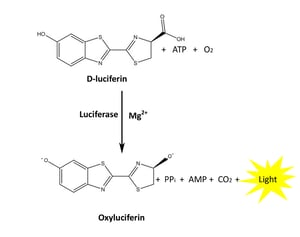 Reporters have contributed significantly to the field of biology and its progress. Genetic reporters are widely used in drug development, biomedical research, and biochemistry. In a nutshell, the reporter gene is fused with the gene of interest and cloned into an expression vector. The expression vector with the chimeric sequence is transferred into suitable cells. The expression of the gene in the cell is measured by the activity of the reporter protein. A textbook good reporter gene should have high sensitivity and can be measured quantitatively after expression.
Reporters have contributed significantly to the field of biology and its progress. Genetic reporters are widely used in drug development, biomedical research, and biochemistry. In a nutshell, the reporter gene is fused with the gene of interest and cloned into an expression vector. The expression vector with the chimeric sequence is transferred into suitable cells. The expression of the gene in the cell is measured by the activity of the reporter protein. A textbook good reporter gene should have high sensitivity and can be measured quantitatively after expression.
The most common reporters are bioluminescent reporters whose detection is based on the enzymatic reaction with an enzyme, Luciferase, with the substrate Luciferin. The most commonly used luciferase enzymes are derived from firefly (Photinus pyralis) and Renilla (Renilla reniformis). The bioluminescent signal emitted from this reporter enzymatic reaction can be quantified easily.
These cell-based assay systems are successful in measuring the expression of a gene with high sensitivity. The signal produced can be measured with a simple luminometer consisting of a series of photomultipliers or a charge-coupled device (CCD) camera.
There are many modifications of Luciferase assay available depending upon the experimental requirements.
- Single Luciferase Reporter Assay:
This is used to analyze gene expression and promoter analysis in bacteria or eukaryotic cells. This assay requires an excess of luciferin and ATP. It involves classical luciferase protocol in which the chimeric plasmid (luciferase gene and the target promoter) is transfected into the cells followed by lysis for some time. The expression of luciferase protein along with the targeted gene is estimated by the light intensity in in-vitro. This method is highly sensitive and has a broader linear response (in the magnitude of 7-8). It is suitable for high throughput screening because of its simplicity and usefulness in wide areas of gene expression, protein-protein interactions, and post-transcriptional. The caveat of this assay is normalization of internal enzyme activity to ensure the accuracy of the result.
- Dual-Luciferase Reporter assay:
This system utilizes an internal control reporter to enhance experimental accuracy and minimize internal experimental variability at different parameters in terms of variability of number and viability of the transfected cells, the efficiency of transfection, lysis of the cells and harvest time. For most of the cell biology experiments, firefly luciferase is used as the experimental reporter and Renilla luciferase is used as an internal control fused with housekeeping or constitutively expressing promoters such as SV40 or CMV promoter.
From the cell sample, activities of both of the luciferases are measured sequentially depending upon their substrates. In the first reaction, D-luciferin is used to assess the activity of firefly luciferase followed by Renilla luciferin for Renilla luciferase with a parallel signal quenching of firefly luciferase signal. The final activity is measured as firefly luciferase activity normalized by internal Renilla luciferase activity.
This assay is useful for high throughput screening of bioactive compounds and gene expression but for large-scale sampling, this is not the best available method.
- Multicolored Luciferase Reporter assay:
This assay is a one-step method for simultaneous monitoring of many extracts. It is useful for large-scale data interpretation in lesser time and amount of sample. Different beetle luciferases are utilized to emit different colors using modified luciferases and all the emissions can be detected separately. Luciferases (CBGluc, CBRluc, ELuc, SLR, SLG, and SLO) from different beetle species are used in a wide spectral range. Most of these genes are different from classical luciferase gene by point mutations. Since only one substrate (firefly D-luciferin) is required for the activation of all these genes, many targeted genes can be assessed by just one-step reaction in only one sample.
- Real-Time Luciferase Reporter Assay:
Using a real-time monitoring photomultiplier system, luminescence can be measured in multi-dimensions (both quantitatively and longitudinally) with high resolution both in the in-vitro and in-vivo system. D-luciferin can penetrate well inside the cells and tissues and is very stable, therefore, used in combination with Renilla luciferin.
Luciferase-based assays are better than other reports because of the following advantages:
- Quick and real-time measurement.
- Exceptionally high sensitivity than fluorescent reporters like GFP (10- to 1,000 fold)
- Range of measurement is wide and dynamic.
- Proper controls are available to negate endogenous activity.
- Clear signals with minimal background.
- Linear response range which is better than typical enzymatic reporters such as β-galactosidase, chloramphenicol acetyltransferase, β-glucuronidase
Applications of Luciferase assays:
- non-invasive labeling of genes in live animals
- Cell viability assay
- Estimation of ATP or internal calcium in cells
- Gene expression analysis
- Promoter structure analysis
- Functional SNPs analysis for the promoter
- Studying Cell signaling pathways
- To study RNAi and non-coding RNAs






